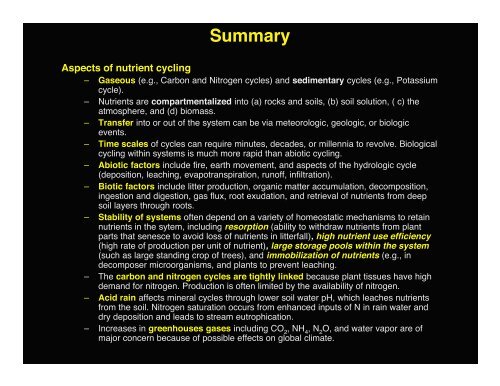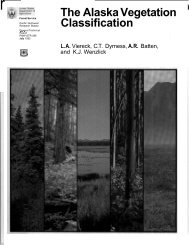Lesson 32 Mineral Cycling - Alaska Geobotany Center
Lesson 32 Mineral Cycling - Alaska Geobotany Center
Lesson 32 Mineral Cycling - Alaska Geobotany Center
Create successful ePaper yourself
Turn your PDF publications into a flip-book with our unique Google optimized e-Paper software.
Summary<br />
Aspects of nutrient cycling<br />
– Gaseous (e.g., Carbon and Nitrogen cycles) and sedimentary cycles (e.g., Potassium<br />
cycle).<br />
– Nutrients are compartmentalized into (a) rocks and soils, (b) soil solution, ( c) the<br />
atmosphere, and (d) biomass.<br />
– Transfer into or out of the system can be via meteorologic, geologic, or biologic<br />
events.<br />
– Time scales of cycles can require minutes, decades, or millennia to revolve. Biological<br />
cycling within systems is much more rapid than abiotic cycling.<br />
– Abiotic factors include fire, earth movement, and aspects of the hydrologic cycle<br />
(deposition, leaching, evapotranspiration, runoff, infiltration).<br />
– Biotic factors include litter production, organic matter accumulation, decomposition,<br />
ingestion and digestion, gas flux, root exudation, and retrieval of nutrients from deep<br />
soil layers through roots.<br />
– Stability of systems often depend on a variety of homeostatic mechanisms to retain<br />
nutrients in the sytem, including resorption (ability to withdraw nutrients from plant<br />
parts that senesce to avoid loss of nutrients in litterfall), high nutrient use efficiency<br />
(high rate of production per unit of nutrient), large storage pools within the system<br />
(such as large standing crop of trees), and immobilization of nutrients (e.g., in<br />
decomposer microorganisms, and plants to prevent leaching.<br />
– The carbon and nitrogen cycles are tightly linked because plant tissues have high<br />
demand for nitrogen. Production is often limited by the availability of nitrogen.<br />
– Acid rain affects mineral cycles through lower soil water pH, which leaches nutrients<br />
from the soil. Nitrogen saturation occurs from enhanced inputs of N in rain water and<br />
dry deposition and leads to stream eutrophication.<br />
– Increases in greenhouses gases including CO 2<br />
, NH 4<br />
,N 2<br />
O, and water vapor are of<br />
major concern because of possible effects on global climate.
















